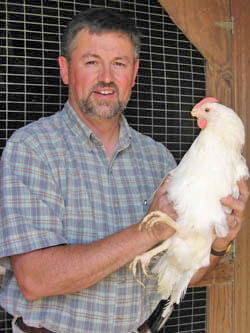AU Poultry Research Yields Animal Model for Ovarian Cancer Prevention
By: Jamie Creamer
CoAg poultry scientist's research into the reproductive processes of egg-laying hens could hold keys to the early detection and perhaps eventually the prevention of ovarian cancer—the most fatal of all gynecological malignancies—in humans.
Working in collaboration with University of Alabama at Birmingham oncologists, AU assistant professor and Alabama Agricultural Experiment Station researcher Wallace Berry has established that commercial laying hens, because they have a hormonal cycle and ovarian surface cells that are remarkably similar to humans' and because they have a high rate of naturally occurring ovarian cancer, are valid animal models for ovarian cancer research. In fact, by 5 years of age, 40 percent of white-leghorn laying hens spontaneously develop ovarian cancer.

Wallace Berry's major research focuses on improving reproductive efficiency in broiler breeders
"Animal models are crucial to understanding the causes of diseases and developing new treatments, but there have been no acceptable ones for ovarian cancer research," Berry says. "Having the hen as a viable experimental model now allows us to study how the disease originates, how to detect it earlier, how to treat it more effectively and how to prevent it. Our main focus is early diagnosis and, ultimately, prevention."
Ovarian cancer represents the fourth leading cause of cancer deaths in women in the United States, largely because it most often is not detected until it's in the advanced stages. Some 75 percent of ovarian cancer cases in the U.S. are not diagnosed until they have spread beyond the ovaries, and in those cases, the chance of five-year survival is only about 25 percent. The American Cancer Society estimates 22,000 women will be diagnosed with ovarian cancer this year; more than 16,000 women will die of the disease.
The general observation long has been that the more ovulations a woman experiences throughout her lifetime and the fewer pregnancies and other disruptions in her hormonal cycle, the greater her risk of developing ovarian cancer. Hens are a strong animal model, Berry said, because they ovulate 250-plus times a year—the equivalent to 20 years of ovulation for a human female.
In one phase of his research, Berry has found that administering progesterone to laying hens for a year and thus temporarily interrupting the reproductive cycle lowers the rate of ovarian cancer in the birds from 40 percent to 25 percent. Progesterone is a female sex hormone used in birth control pills to prevent ovulation.
Currently, Berry is investigating the theory that inflammation of the ovaries due to such conditions as endometriosis, ovarian cysts and hyperthyroidism increases the risk of ovarian cancer. He is testing anti-inflammatory drugs to determine whether they, too, lower the incidence of ovarian cancer in the chickens.
Berry, whose major research at Auburn focuses on improving reproductive efficiency in broiler breeders, noted that commercial egg-laying hens are kept in production only until 2 years of age and that malignant tumors rarely develop in hens that young. Berry's ovarian cancer research involves hens 3-5 years of age.
